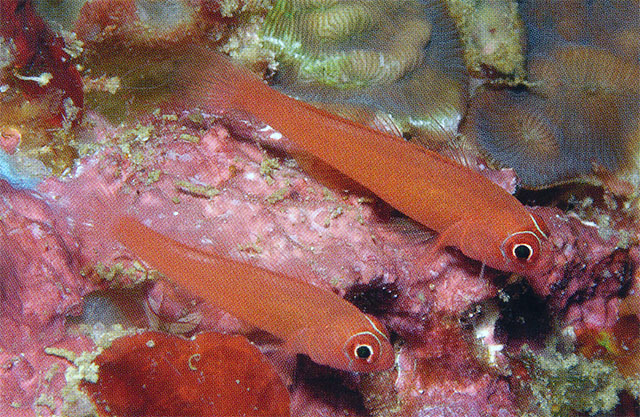| Gobiidae (Gobies), subfamily: Gobiinae |
| 3 cm SL (male/unsexed); max. reported age: 0 years |
|
reef-associated; marine; depth range 1 - 90 m |
| Western Pacific: Sulawesi to Tonga; north to Marshall Islands; south to New Caledonia and the Great Barrier Reef. |
|
Dorsal spines (total): 7-7; Dorsal soft rays (total): 9-10; Anal spines: 1-1; Anal soft rays: 8-10. Distinguished by having the following characters: a deep concave, ‘U’-shaped interorbital trench; the bony interorbital about half pupil-diameter in width; with a slight groove posterodorsal to the eye; without median predorsal scales, sides of nape covered with small scales reaching to or near to the eyes; cheek and operculum without scales; base of pectoral-fin with oval, moderate-sized scales; prepelvic area with 5-6 rows of cycloid scales, isthmus naked anteriorly, with one slightly enlarged scale on the membrane between the bases of the pelvic fins; central 6-13 pectoral rays branched, uppermost and lowermost rays unbranched; fifth pelvic-fin ray branched once dichotomously and about 60-75% length of the fourth; all other rays usually with one sequential branch, basal membrane connecting the two pelvic fins only at the base; second dorsal spine longest, usually filamentous, extending at most to midway along the base of the second dorsal fin in Australian material; D2 usually I,10; A usually I, 9; nape crest fleshy from the first dorsal origin to above the operculum; when alive, head and body red, preserved yellow, the head with a thin vertical grey (bluish grey in life) bar from the anteroventral margin of the eye to the middle of the jaws and a second bar extending more-or-less vertically downward onto cheek from about the middle of the eye (often persisting in preserved material as faint grey bars); orbit rimmed with a thin band of melanophores, more distinct dorsally but faded in preserved material (Ref. 100726). |
| Specimens were collected with rotenone (Ref. 13702). Inhabits coastal and outer reef slopes (Ref. 37816, 48637). Benthic, occuring singly or in loose groups, and a plankton-feeder; with prolonged pelagic larval duration of 33.9 days (= 24% of maximum lifespan) and linear post-larval growth; daily mortality rate ranging from 2.9% to 6.3%; sex ratio of 1:1.6 male/females) (Ref. 87294). |
|
Least Concern (LC); Date assessed: 11 March 2015 Ref. (130435)
|
| harmless |
Source and more info: www.fishbase.org. For personal, classroom, and other internal use only. Not for publication.

